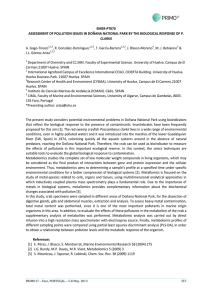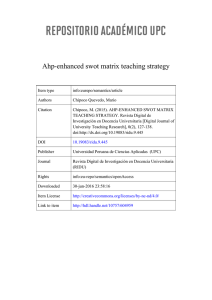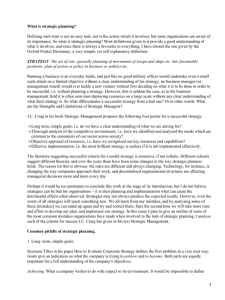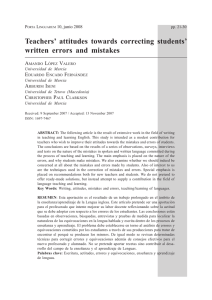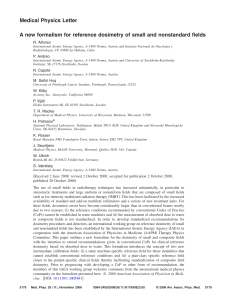Preanalytical errors: the professionals
Anuncio
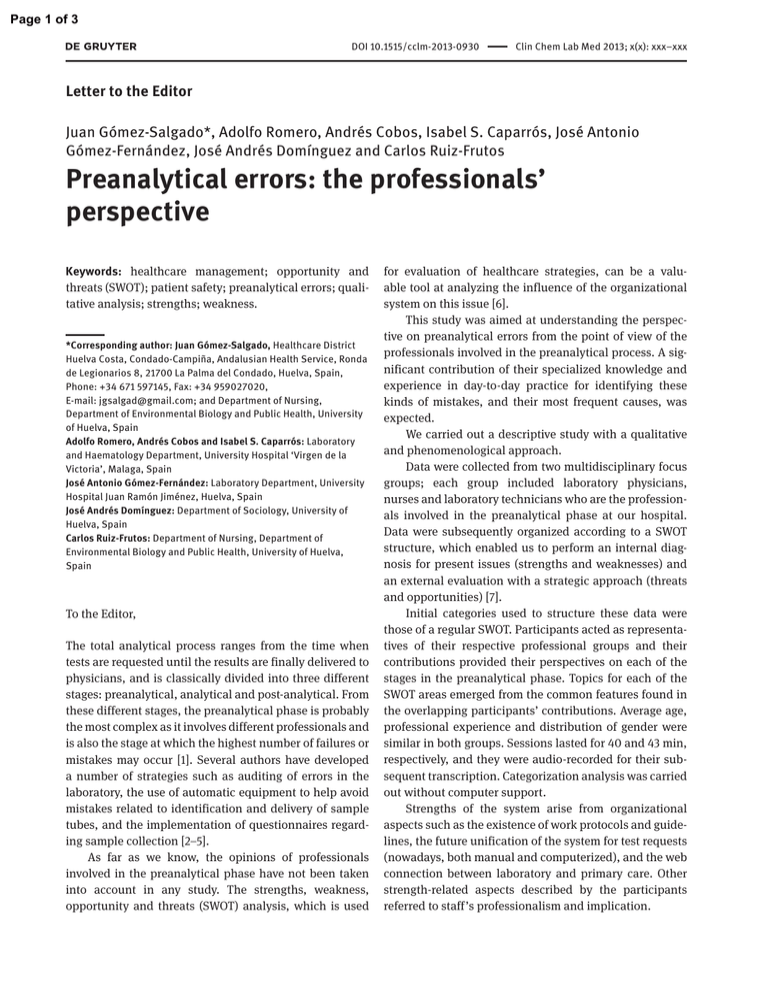
Page 1 of 3 DOI 10.1515/cclm-2013-0930 Clin Chem Lab Med 2013; x(x): xxx–xxx Letter to the Editor Juan Gómez-Salgado*, Adolfo Romero, Andrés Cobos, Isabel S. Caparrós, José Antonio Gómez-Fernández, José Andrés Domínguez and Carlos Ruiz-Frutos Preanalytical errors: the professionals’ perspective Keywords: healthcare management; opportunity and threats (SWOT); patient safety; preanalytical errors; qualitative analysis; strengths; weakness. *Corresponding author: Juan Gómez-Salgado, Healthcare District Huelva Costa, Condado-Campiña, Andalusian Health Service, Ronda de Legionarios 8, 21700 La Palma del Condado, Huelva, Spain, Phone: +34 671 597145, Fax: +34 959027020, E-mail: jgsalgad@gmail.com; and Department of Nursing, Department of Environmental Biology and Public Health, University of Huelva, Spain Adolfo Romero, Andrés Cobos and Isabel S. Caparrós: Laboratory and Haematology Department, University Hospital ‘Virgen de la Victoria’, Malaga, Spain José Antonio Gómez-Fernández: Laboratory Department, University Hospital Juan Ramón Jiménez, Huelva, Spain José Andrés Domínguez: Department of Sociology, University of Huelva, Spain Carlos Ruiz-Frutos: Department of Nursing, Department of Environmental Biology and Public Health, University of Huelva, Spain To the Editor, The total analytical process ranges from the time when tests are requested until the results are finally delivered to physicians, and is classically divided into three different stages: preanalytical, analytical and post-analytical. From these different stages, the preanalytical phase is probably the most complex as it involves different professionals and is also the stage at which the highest number of failures or mistakes may occur [1]. Several authors have developed a number of strategies such as auditing of errors in the laboratory, the use of automatic equipment to help avoid mistakes related to identification and delivery of sample tubes, and the implementation of questionnaires regarding sample collection [2–5]. As far as we know, the opinions of professionals involved in the preanalytical phase have not been taken into account in any study. The strengths, weakness, opportunity and threats (SWOT) analysis, which is used for evaluation of healthcare strategies, can be a valuable tool at analyzing the influence of the organizational system on this issue [6]. This study was aimed at understanding the perspective on preanalytical errors from the point of view of the professionals involved in the preanalytical process. A significant contribution of their specialized knowledge and experience in day-to-day practice for identifying these kinds of mistakes, and their most frequent causes, was expected. We carried out a descriptive study with a qualitative and phenomenological approach. Data were collected from two multidisciplinary focus groups; each group included laboratory physicians, nurses and laboratory technicians who are the professionals involved in the preanalytical phase at our hospital. Data were subsequently organized according to a SWOT structure, which enabled us to perform an internal diagnosis for present issues (strengths and weaknesses) and an external evaluation with a strategic approach (threats and opportunities) [7]. Initial categories used to structure these data were those of a regular SWOT. Participants acted as representatives of their respective professional groups and their contributions provided their perspectives on each of the stages in the preanalytical phase. Topics for each of the SWOT areas emerged from the common features found in the overlapping participants’ contributions. Average age, professional experience and distribution of gender were similar in both groups. Sessions lasted for 40 and 43 min, respectively, and they were audio-recorded for their subsequent transcription. Categorization analysis was carried out without computer support. Strengths of the system arise from organizational aspects such as the existence of work protocols and guidelines, the future unification of the system for test requests (nowadays, both manual and computerized), and the web connection between laboratory and primary care. Other strength-related aspects described by the participants referred to staff ’s professionalism and implication. Page 2 of 3 2 Gómez-Salgado et al.: Preanalytical errors: the professionals’ perspective Main weaknesses found in the in-hospital preanalytical phase of samples from primary care facilities are mostly related to organizational problems, and they were caused by deficiencies in tube handling for different samples, the coexistence of two ways for test request, as mentioned above, or outdated equipment (both technical or informatics devices). In addition, we found deficiencies in information to service users before sample collection, as well as in training, due to frequent staff personnel turnover. Foreseen opportunities were also based on organizational aspects, such as the introduction of an informaticsbased platform for the entire process (from test request to results delivery), which may result in a significant reduction of handwritten requests, and the review and/or development of protocols and guidelines. Other opportunities pointed out by participants were related to enhance training and information. Threats are mostly related to the financial crisis and its influence, which causes a lack of professionals (in number and motivation), and motivation, with an evident increase of workload. Focus groups, combined with a SWOT structure for implementation, may constitute a useful tool to evaluate preanalytical processes in the laboratory environment. It is helpful when promoting changes and structural modifications, to elaborate actions and develop cooperation networks [8]. Negative aspects were found mainly in: 1) training deficiencies; 2) deficient or not optimized work organization; and 3) increased work load; financial crisis and communication problems acting as external factors. At the same time, the importance of organization improvement was highlighted, together with professionalism and implication of the staff involved in the process. Knowledge exchange emerges as an element for improvement. The lack of training and organizational aspects can be connected, as the institution must provide continuous professional education, knowledge exchange and elaboration of joined policies. The financial crisis in the background seems to have had major importance in the comments provided by the participants. Among the consequences of the crisis, the higher workload was seen by the participants as the origin of a high proportion of detected mistakes. Poor patient’s preparation and inadequate knowledge of laboratory procedures among primary care staff are both problems that can be probably solved and effective strategies (i.e., formative programs) have been implemented with different results [7, 9]. Among all the aspects pointed out by participants, these are probably the most likely to cause preanalytical errors. These concerns among professionals are coherent with the number of preanalytical errors detected previously in our laboratory (around 8%–9%) and with the failure of an initial attempt to reduce them [9]. This led to planning a new research project in which this study was one of the objectives; if we can increase our knowledge of these kinds of mistakes, we will probably have more weapons to fight against them, i.e., early detection. It seems evident that weaknesses and threats are closely related to institutional organization aspects and the same is true for positive elements (strengths and opportunities). There is also an important appreciation of the staff ’s implication. Staff´s opinions should be taken into account by institution managers, as they offer an approach that is different and complementary to the one traditionally applied, which is purely managerial and therefore not sufficient. The results should be complemented with more updated information. Multidisciplinary cooperation must involve not only professionals from different fields but also with different roles, i.e., managers, in order to obtain results that can be used to improve healthcare, save costs and to guarantee patient’s safety. We will continue with this research line investigating the same questions among primary care staff, in order to assess “the other side of the coin” of this problem. Conflict of interest statement Authors’ conflict of interest disclosure: The authors stated that there are no conflicts of interest regarding the publication of this article. Research funding played no role in the study design; in the collection, analysis, and interpretation of data; in the writing of the report; or in the decision to submit the report for publication. Research funding: This article was partially funded by project grant PI 12/1099 from Fondo de Investigaciones Sanitarias, Instituto de Salud Carlos III, Spanish Government. Employment or leadership: None declared. Honorarium: None declared. Received October 14, 2013; accepted November 5, 2013 Page 3 of 3 Gómez-Salgado et al.: Preanalytical errors: the professionals’ perspective 3 References Q1: Please confirm the 1. Romero A, Muñoz M, Ramos JR, Campos A, Ramirez G. Preanalytical mistakes in a stat laboratory. Clin Lab Chem Med 2005;43:974–5. author name 2. Plebani M, Carraro P. Mistakes in a stat laboratory: types and and article frequency. Clin Chem 1997;43:1348–51. title for 3. Plebani M. Exploring the iceberg of errors in laboratory medicine. ref. [1] Clin Chim Acta 2009;404:16–23. 4. Romero A, Cobos A, López-León A, Ortega G, Muñoz M. Preanalytical mistakes in samples from primary care patients. Clin Chem Lab Med 2009;47:1549–52. 5. Da Rin G. Pre-analytical workstations: a tool for reducing laboratory errors. Clin Chim Acta 2009;404:68–74. 6. Anexo IV A. Elaboración de un análisis DAFO en organizaciones de transportes. Modelos para implantar la mejora continua en la gestión de empresas de transporte por carretera. Madrid: Ministerio de Fomento, 2005. 7. Söderberg J, Wallin O, Grankvist K, Brulin C. Is the test result correct? A questionnaire study of blood collection practices in primary health care. J Eval Clin Pract 2010;16:707–11. 8. Romero Ruiz A, Ávila Rodríguez IM, Tronchoni de los Llanos J, Muñoz Gómez M. Estrategias para la disminución de errores imputables a la toma de muestras sanguíneas. Evidentia. 2007;4. 9. Romero A, Cobos A, Gómez-Salgado J, Muñoz M. Role of training activities for the reduction of pre-analytical errors in laboratory samples from primary care. Clin Chim Acta 2012;413:166–9. Q2: Please supply the page range for ref. [8]
